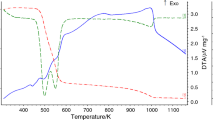Summary
Formation of antimony polyphosphate using Sb2O3 and/or (NH4)2HPO4 and NH4H2PO4 as starting materials has been simulated by thermal analysis technique. The elimination of water and ammonia molecules induced by heating leads to the formation of intermediate ammonium polyphosphate, which subsequently reacts with Sb2O3. Morphologically, vitreous Sb(PO3)3 is composed of plaques having irregular shapes. Infrared spectra and NMR study is consistent with tetrametaphosphate anion arrangement. The compound is thermally unstable and may be recommended as a donor of -O-P-O- linkers in the preparation of special phosphate glasses.
Similar content being viewed by others
Author information
Authors and Affiliations
Rights and permissions
About this article
Cite this article
Melnikov, P., dos Santos, F., Santagnelli, S. et al. Mechanism of the formation and properties of antimony polyphosphate. J Therm Anal Calorim 81, 45–49 (2005). https://doi.org/10.1007/s10973-005-0743-1
Issue Date:
DOI: https://doi.org/10.1007/s10973-005-0743-1




